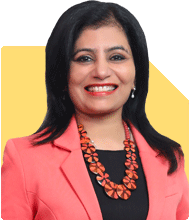41-Year-Old High-Earner Seeks Retirement Plan - On Track with 20-25 Crore Goal?
Ramalingam Kalirajan |8365 Answers |Ask -Follow
Mutual Funds, Financial Planning Expert - Answered on Oct 16, 2024
He has an MBA in finance from the University of Madras and is a certified financial planner.
He is the director and chief financial planner at Holistic Investment, a Chennai-based firm that offers financial planning and wealth management advice.... more

Am 41 yr old , earning 10-15 lakh per month with 2.5 lakh expense and 80 k emi which will b closed in 2 yrs , my asset 5 Cr asset in real estate ( 3 flat and 2 land ) , 50 lakh FD , total 2 lakh monthly mutual month investment now mutual fund total portfolio reached 60 lakh And around 1 Cr liquidabale high risk high return investment ( 20% earning diversified) Have 2 LIC one maturing in 2026 mature amount 25 lakh Another in 2030 30 lakh I wish to retire after 10 yrs Need retirement corpus of 20-25 Cr Am in right path ?
Let’s break down your financial scenario step by step, assess if you are on the right track, and offer suggestions for improvement.
Your Financial Snapshot
Income: Rs 10-15 lakh per month
Monthly Expenses: Rs 2.5 lakh
EMI: Rs 80,000 per month, which will close in 2 years
Assets:
Real Estate: Rs 5 crore (3 flats and 2 plots)
Fixed Deposit: Rs 50 lakh
Mutual Fund Portfolio: Rs 60 lakh, with Rs 2 lakh monthly SIPs
High-Risk Investments: Rs 1 crore with 20% annual returns
LIC Policies: Rs 25 lakh maturing in 2026 and Rs 30 lakh maturing in 2030
Retirement Corpus Goal: Rs 20-25 crore in 10 Years
You aim to retire with Rs 20-25 crore in 10 years. It is an ambitious but achievable goal, given your income and current assets. However, the challenge lies in aligning your investments in a way that generates the necessary growth, with a balance between risk and returns. Here’s an evaluation of where you stand today and what adjustments may be needed.
Assessing Your Current Assets
Real Estate: Rs 5 crore
You have invested Rs 5 crore in real estate, including three flats and two plots. While this is a substantial amount and adds to your wealth, there are some key considerations:
Liquidity: Real estate is generally illiquid. Selling property can take time, and real estate prices fluctuate based on market conditions. This makes it a less reliable source of immediate funds during retirement.
Cash Flow: Unless these properties are generating rental income, they won’t contribute to your regular cash flow in retirement. Rental income can supplement your retirement, but it’s unpredictable and subject to market dynamics.
Investment Perspective: For retirement planning, liquid and growth-oriented investments are more suitable. Real estate, while a valuable asset, may not provide the steady returns you’ll need during your retirement years.
Mutual Fund Portfolio: Rs 60 lakh + Rs 2 lakh Monthly SIP
Your Rs 60 lakh mutual fund portfolio is a strong foundation. With a monthly SIP of Rs 2 lakh, you are investing in a growth-oriented vehicle. Let’s assess its potential:
Growth Potential: Assuming a conservative 12% annual return over the next 10 years, your mutual fund portfolio could grow significantly. In 10 years, this could potentially accumulate Rs 4-5 crore. However, to reach your retirement target of Rs 20-25 crore, you’ll need to increase your SIPs gradually.
SIP Top-Up Strategy: One of the best ways to ensure your mutual funds keep pace with your retirement goal is by increasing your SIP contributions annually. With rising income and the closure of your EMI in two years, you can redirect these funds toward increasing your SIPs.
High-Risk Investments: Rs 1 crore (20% returns)
You’ve allocated Rs 1 crore to high-risk, high-return investments with a 20% return expectation. While this is impressive, relying too much on high-risk investments for retirement can be problematic.
Risk Consideration: High returns come with high risk. As you get closer to retirement, it’s essential to reduce exposure to volatile investments. You don’t want to jeopardize your retirement corpus by holding too much in high-risk instruments.
Rebalance Gradually: Over time, you should consider moving a portion of these funds into more stable, diversified mutual funds or hybrid funds. This way, you can safeguard your retirement corpus while still aiming for growth.
Fixed Deposit: Rs 50 lakh
A Rs 50 lakh fixed deposit provides security, but it won’t help you grow your corpus significantly.
Low Returns: FDs typically offer lower returns compared to other investment options. Over the long term, inflation erodes the purchasing power of FD returns.
Alternative Options: You might want to explore safer mutual fund categories, such as debt mutual funds, which offer better returns and tax efficiency than FDs.
LIC Policies: Rs 25 lakh in 2026 and Rs 30 lakh in 2030
You have two LIC policies maturing in 2026 and 2030, which will provide you with Rs 55 lakh.
Low Yield: Traditional LIC policies often provide returns lower than equity or mutual fund investments. While they offer security, the returns might not align with your retirement goal.
Post-Maturity Strategy: Once these policies mature, reinvest the proceeds into growth-oriented mutual funds or other higher-return instruments. This can boost your corpus further during the final stretch of your retirement planning.
Evaluating Your Progress
You have an excellent foundation for achieving your Rs 20-25 crore retirement corpus. Here’s a summary of your current progress:
Real Estate: Rs 5 crore (not a liquid retirement asset)
Mutual Funds: Rs 60 lakh with Rs 2 lakh monthly SIPs
High-Risk Investments: Rs 1 crore, growing at 20% per annum
Fixed Deposit: Rs 50 lakh
LIC Policies: Rs 55 lakh maturing in 2026 and 2030
The key areas of improvement include increasing your SIPs, reducing reliance on high-risk investments, and finding alternatives to low-yield investments like FDs and LIC policies.
Recommendations for Growth and Stability
Increase SIP Contributions
To meet your retirement goal, consider increasing your SIP contributions over time. This will help your portfolio grow faster.
Top-Up SIP Strategy: You could increase your SIP by 10-15% each year. For example, after your EMI closes in two years, you can divert the Rs 80,000 into additional SIPs. This strategy helps ensure your investments keep pace with inflation and your growing income.
Diversify High-Risk Investments
Your Rs 1 crore in high-risk investments is providing excellent returns, but you should not rely too heavily on it for your retirement corpus.
Reduce Exposure Over Time: As you near retirement, begin shifting a portion of these funds into more stable mutual funds or hybrid funds. This will reduce volatility in your portfolio while still providing growth.
Balanced Approach: A balanced approach with a mix of equity and debt mutual funds can provide both growth and stability. Aim for a portfolio that gradually becomes more conservative as you approach your retirement date.
Reconsider Fixed Deposits
Fixed deposits are safe but offer limited growth.
Shift to Debt Mutual Funds: You may want to move part of your FD savings into debt mutual funds, which can offer better returns and are more tax-efficient. Debt funds, particularly those with low credit risk, can provide stability and liquidity while outperforming FDs.
LIC Maturity Reinvestment
Once your LIC policies mature, reinvest the proceeds wisely.
Reinvest in Growth Funds: After 2026 and 2030, when your LIC policies mature, consider reinvesting the Rs 55 lakh into diversified mutual funds. This will help accelerate the growth of your retirement corpus during the final years of your working life.
Focus on Tax Efficiency
Your portfolio should also consider tax efficiency, particularly as you approach retirement.
Equity Mutual Funds: Gains above Rs 1.25 lakh are taxed at 12.5%. Plan your withdrawals accordingly to minimise taxes.
Debt Mutual Funds: Gains in debt mutual funds are taxed according to your income slab. These can still be more efficient than FDs due to indexation benefits over the long term.
Regular Review and Adjustments
Retirement planning is not a one-time exercise. You should regularly review and adjust your portfolio.
Annual Review: Sit down with a Certified Financial Planner each year to review your progress. This ensures that your investments are on track and that you’re making the necessary adjustments based on market conditions and personal changes.
Rebalancing: As your mutual fund portfolio grows, periodically rebalance between equity and debt to ensure your portfolio remains aligned with your risk tolerance and retirement goals.
Projecting Your Retirement Corpus
Based on the current investments and a disciplined approach to increasing your SIPs, you are likely to accumulate between Rs 15-18 crore in 10 years. Achieving Rs 25 crore will require higher risk-taking or an extension of your retirement timeline by a few years.
However, your diversified portfolio, combined with regular reviews, can still provide you with a comfortable retirement if managed well.
Finally
You are on a strong path to retirement with your existing assets and investment plan. However, to ensure you reach your goal of Rs 20-25 crore, consider the following:
Gradually increase your SIPs to boost your mutual fund portfolio.
Diversify your high-risk investments over time to reduce volatility.
Move away from low-yield options like FDs, and reinvest LIC maturities into higher-growth funds.
Review your investments annually with a Certified Financial Planner to stay on track.
By following this strategy, you can confidently build a retirement corpus that ensures a secure and comfortable retirement.
Best Regards,
K. Ramalingam, MBA, CFP,
Chief Financial Planner,
www.holisticinvestment.in
https://www.youtube.com/@HolisticInvestment
You may like to see similar questions and answers below
Ramalingam Kalirajan |8365 Answers |Ask -Follow
Mutual Funds, Financial Planning Expert - Answered on Aug 28, 2024
Milind Vadjikar |1223 Answers |Ask -Follow
Insurance, Stocks, MF, PF Expert - Answered on Oct 12, 2024
Milind Vadjikar |1223 Answers |Ask -Follow
Insurance, Stocks, MF, PF Expert - Answered on Nov 27, 2024
Ramalingam Kalirajan |8365 Answers |Ask -Follow
Mutual Funds, Financial Planning Expert - Answered on Dec 25, 2024
Dr Nagarajan J S K |392 Answers |Ask -Follow
NEET, Medical, Pharmacy Careers - Answered on May 14, 2025
Dr Nagarajan J S K |392 Answers |Ask -Follow
NEET, Medical, Pharmacy Careers - Answered on May 14, 2025
Dr Nagarajan J S K |392 Answers |Ask -Follow
NEET, Medical, Pharmacy Careers - Answered on May 14, 2025
Dr Nagarajan J S K |392 Answers |Ask -Follow
NEET, Medical, Pharmacy Careers - Answered on May 14, 2025
Archana Deshpande |113 Answers |Ask -Follow
Image Coach, Soft Skills Trainer - Answered on May 14, 2025
Archana Deshpande |113 Answers |Ask -Follow
Image Coach, Soft Skills Trainer - Answered on May 14, 2025
Milind Vadjikar |1223 Answers |Ask -Follow
Insurance, Stocks, MF, PF Expert - Answered on May 14, 2025
Archana Deshpande |113 Answers |Ask -Follow
Image Coach, Soft Skills Trainer - Answered on May 14, 2025
Milind Vadjikar |1223 Answers |Ask -Follow
Insurance, Stocks, MF, PF Expert - Answered on May 14, 2025
Milind Vadjikar |1223 Answers |Ask -Follow
Insurance, Stocks, MF, PF Expert - Answered on May 14, 2025






















